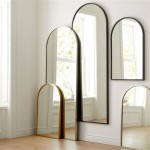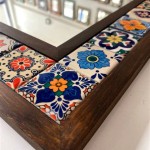Antiqued Glass Mirror Restoration Hardware
Antique mirrors offer a unique charm and a glimpse into the past. Their aged patina and often intricate frames contribute to their aesthetic appeal. However, the passage of time can take its toll, necessitating restoration to preserve their beauty and value. This process often requires specialized hardware, carefully selected to respect the mirror's historical integrity while ensuring its structural soundness.
One of the primary concerns in antique mirror restoration is addressing damaged or deteriorated backing. Historically, mirrors were backed with materials like wood, tin, or even paper. Over time, these materials can warp, rot, or become detached, leading to instability and potential damage to the reflective surface. Restoration hardware for addressing backing issues includes archival-quality backing boards, such as acid-free foam board or archival-grade plywood. These materials provide a stable and protective backing while minimizing the risk of chemical reactions that could harm the antique glass.
Securing the mirror to its frame is another crucial aspect of restoration. Original fasteners might be rusted, missing, or simply inadequate for providing long-term stability. Restoration hardware options include specialized mirror clips designed to grip the glass securely without excessive pressure. These clips are often available in various sizes and finishes to accommodate different mirror thicknesses and frame styles. For frames with existing channels for holding the glass, spring clips can be a suitable choice, offering secure retention while allowing for slight movement to accommodate expansion and contraction due to temperature fluctuations.
Antique mirror frames often feature intricate carvings, decorative elements, or gilding that requires careful attention during restoration. Damaged or missing frame sections may need to be replaced or repaired using appropriate restoration techniques. Hardware for frame restoration includes specialized adhesives formulated for bonding aged wood and other materials, as well as small brass brads and finishing nails for securing repairs discreetly. When working with gilded frames, it is essential to use non-reactive adhesives and cleaning agents to prevent damage to the delicate gold leaf.
Addressing issues related to the antique glass itself requires careful consideration and specialized techniques. Cleaning antique mirrors requires gentle methods and appropriate cleaning solutions to avoid damaging the reflective surface or any existing silvering. Mild detergents and distilled water are often recommended, along with soft, lint-free cloths. Avoid abrasive cleaners or harsh chemicals, as these can scratch the glass or damage the delicate silvering. For severely deteriorated silvering, professional re-silvering might be necessary, a process that involves applying a new layer of reflective material to the back of the glass.
Hanging hardware is another important consideration in antique mirror restoration. Original hanging hardware may be fragile, damaged, or simply unsuitable for the mirror’s weight and size. Selecting appropriate hanging hardware involves assessing the mirror’s weight and dimensions, as well as the wall material where it will be hung. Heavy-duty picture wire rated for the mirror's weight, along with D-rings or wire hangers attached to the frame's backing, provide secure and reliable hanging solutions. For exceptionally heavy or large antique mirrors, specialized French cleats or mirror mounting brackets may be necessary for added support and stability.
Sourcing appropriate restoration hardware often involves consulting with antique dealers, conservators, or specialized suppliers of restoration materials. These resources can provide valuable guidance on selecting hardware that is both historically accurate and appropriate for the specific needs of the antique mirror. When selecting hardware, consider the material, finish, and size to ensure compatibility with the mirror’s existing components and overall aesthetic. Using period-appropriate hardware contributes to the authenticity of the restoration and helps preserve the historical integrity of the antique piece.
Proper storage and handling techniques are essential for protecting antique mirrors during the restoration process and beyond. When handling antique mirrors, always support the glass and frame securely to prevent accidental breakage or damage. Wear gloves to avoid leaving fingerprints or transferring oils to the glass or frame. For storage, wrap the mirror in acid-free tissue paper or archival-quality bubble wrap and store it in a climate-controlled environment away from direct sunlight, excessive humidity, or extreme temperature fluctuations. These preventative measures help safeguard the antique mirror and preserve its beauty for future generations.
The selection and use of appropriate restoration hardware play a vital role in preserving the beauty and historical significance of antique mirrors. Careful attention to detail, combined with the use of quality materials and proper techniques, ensures that these cherished objects can continue to be admired and appreciated for years to come.

Restoration Hardware Palazzo Metal Leaf Antiqued Glass Wall Mirror 44 X 60

Restoration Hardware Palazzo Metal Leaf Antiqued Glass Wall Mirror 44 X 60

Restoration Hardware Palazzo Metal Leaf Antiqued Glass Wall Mirror 44 X 60

Restoration Hardware Palazzo Metal Leaf Antiqued Glass Wall Mirror 44 X 60

Antique Glass Mirror Müller Designs

Eichholtz Cedar Modern Classic Antique Glass Rectangular Wall Mirror Large 41 60 Kathy Kuo Home

Antique Mirror Tiles Glass Light Elegant Finish Müller Designs

Restoration Hardware Palazzo Antiqued Glass Round Mirror For In Miami Beach Fl Offerup

Antique Mirror Tiles Vintage Müller Designs

Restoration Hardware Entablature Mirror Frame Decor Antique








